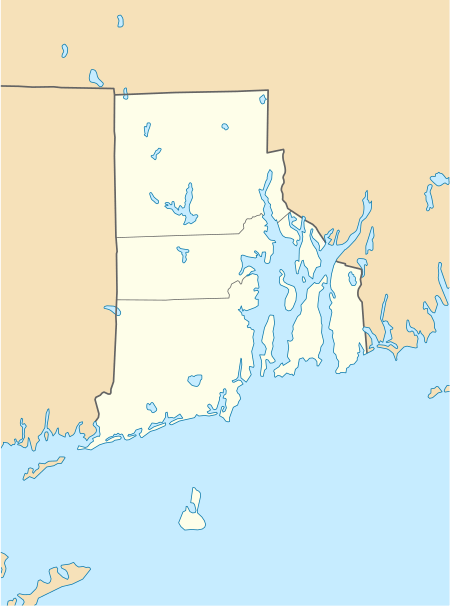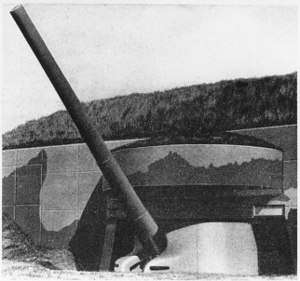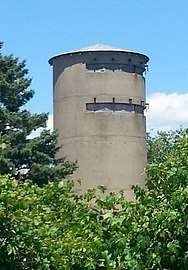Fort Greene (Rhode Island)
Fort Greene may refer to either of two locations in Rhode Island. The first was a small fort built circa 1794 at Battery Park in the Point section of Newport, last active in the War of 1812.[1] The second is a United States Army Reserve installation in the Point Judith area of Narragansett, Rhode Island. During World War II this was a coastal defense fort, and together with Fort Church in Little Compton, it superseded all previous heavy gun defenses in the Harbor Defenses of Narragansett Bay. Both forts were named for General Nathanael Greene of the Revolutionary War, who was born in Rhode Island.[2]
| Fort Greene | |
|---|---|
| Easton's Point, Newport, Rhode Island | |
 Fort Greene Location in Rhode Island | |
| Coordinates | 41°29′49″N 71°19′18″W |
| Type | Coastal Defense |
| Site information | |
| Owner | City of Newport, Battery Park |
| Open to the public | yes |
| Site history | |
| Built | circa 1794 |
| Built by | United States Army |
| In use | circa 1794-1815 |
| Materials | stone |
| Demolished | circa 1820 |
| Battles/wars | War of 1812 |
| Fort Greene | |
|---|---|
| Part of Harbor Defenses of Narragansett Bay | |
| Point Judith, Narragansett, Rhode Island | |
 Fort Greene Location in Rhode Island | |
| Coordinates | 41°22′53″N 71°29′00″W |
| Type | Coastal Defense |
| Site information | |
| Owner | US Army Reserve, State of Rhode Island |
| Controlled by | US Army Reserve, Fishermen's Memorial State Park |
| Open to the public | yes (part) |
| Site history | |
| Built | 1943 |
| Built by | United States Army |
| In use | 1943-present |
| Battles/wars | World War II |


Fort Greene in Newport
Fort Greene in Newport was built as part of the First System of US seacoast fortifications circa 1794. The location is now Battery Park at Easton's Point (now usually called The Point), which was sometimes called North Point in the 18th century. It was on the site of a previous battery built in the American Revolution with state resources, called the North Battery.[3][4] The seawall remains from Fort Greene and is curved at this point.[5]
Fort Greene mounted approximately 12 guns and was intended to house a company of about 100 men, but was never completed.[6] The fort was described in the Secretary of War's report for December 1811 as "an elliptical stone battery... now in a state of ruin".[7] Contemporary forts in Newport included the first Fort Adams and Fort Wolcott.[8] In the War of 1812 the fort was garrisoned by the Newport Artillery. It appears to have been abandoned at some time after that war.
Fort Greene in Narragansett
Fort Greene in Narragansett was built as part of a general modernization of US coast defenses begun in 1940 with the outbreak of war in Europe and the Fall of France. The goal was to replace all previous heavy weapons, many of which were over 35 years old, with long-range 16"/50 caliber Mark 2 guns. Lighter weapons would be replaced by 6-inch guns on high-angle shielded barbette carriages. Ammunition magazines and the 16-inch guns would be in casemated bunkers to protect against air attack.[9]
The fort was intended to protect the approaches to Narragansett Bay as part of the Harbor Defenses of Narragansett Bay, and with a range of over 45,000 yards (41,000 m) it could protect the eastern approaches to Long Island Sound as well. It was mirrored by Fort Church in Little Compton near Sakonnet Point. Three reservations were acquired for Fort Greene 1939-1942, which was initially known as the Point Judith Military Reservation. The East Reservation was at the present Fort Greene Army Reserve Center, while the West and South Reservations are the present Fishermen's Memorial State Park. The South Reservation was near Point Judith Light. Battery Hamilton, or Battery Construction Number (BCN) 108, was on the East Reservation and had two 16-inch guns. BCN 109 was on the West Reservation and was designed for two 16-inch guns, but was never armed. To the west of BCN 109, also in the park, is a plotting room bunker. BCN 211 with two 6-inch guns was on the South Reservation, along with four "Panama mounts" (circular concrete platforms) for towed 155 mm guns.[10] The Point Judith Fishermen's Memorial is next to the bunker of BCN 211; a path is also available to the top of the bunker. No interpretation of the military facilities in the park is provided. In 1947, with the war over, Fort Greene's guns were scrapped along with almost all other US coast artillery weapons.[2]
Several fire control stations were built in Narragansett disguised as beach cottages; these may date from the start of the Endicott Program circa 1900. Most have been destroyed; one (badly damaged by storms) is near BCN 211, and some survive at the Camp Varnum National Guard facility, formerly Fort Varnum.
Present
A former 16-inch gun battery (BCN 109), which was never armed, is in the campground of Fishermen's Memorial State Park on the former west reservation, along with a Plotting, Switchboard, and Radio (PSR) bunker housing a plotting room as part of the Coast Artillery fire control system. The Fort Greene Army Reserve facility, on the east reservation, includes the former 16-inch Battery Hamilton.[11] The former 6-inch gun battery (BCN 211) remains near Point Judith Light, on the former south reservation, also part of the state park. The fishermen's memorial is next to the bunker, and one of the gun blocks is on the (much eroded) beach in front of BCN 211.
Gallery
 6-inch gun position at BCN 211, former Fort Greene south reservation
6-inch gun position at BCN 211, former Fort Greene south reservation Ammunition and fire control bunker for BCN 211, former Fort Greene south reservation
Ammunition and fire control bunker for BCN 211, former Fort Greene south reservation Former fire control tower resembling a barn silo, former Fort Greene west reservation
Former fire control tower resembling a barn silo, former Fort Greene west reservation Storm-damaged former fire control tower resembling a beach cottage, former Fort Greene south reservation
Storm-damaged former fire control tower resembling a beach cottage, former Fort Greene south reservation
References
- Wade, pp. 57, 59
- FortWiki article on Fort Greene
- Wade, p. 16
- North Battery at American Forts Network
- Fort Greene (Newport) at American Forts Network
- Wade, p. 57
- Wade, p. 243
- Wade, p. 59
- Berhow, p. 205
- Berhow, p. 205
- "Operational Range Assessment Program Phase II Report, Fort Nathaniel Greene" (PDF). EA Engineering, Science, and Technology, Inc. October 2012. Archived from the original (PDF) on March 4, 2016. Retrieved August 28, 2014.
- Berhow, Mark A., Ed. (2004). American Seacoast Defenses, A Reference Guide, Second Edition. CDSG Press. ISBN 0-9748167-0-1.
- Lewis, Emanuel Raymond (1979). Seacoast Fortifications of the United States. Annapolis: Leeward Publications. ISBN 978-0-929521-11-4.
- Wade, Arthur P. (2011). Artillerists and Engineers: The Beginnings of American Seacoast Fortifications, 1794-1815. CDSG Press. p. 235. ISBN 978-0-9748167-2-2.
External links
- List of all US coastal forts and batteries at the Coast Defense Study Group, Inc. website
- FortWiki, lists all CONUS and Canadian forts